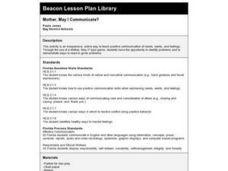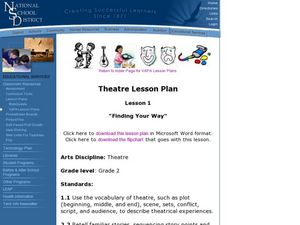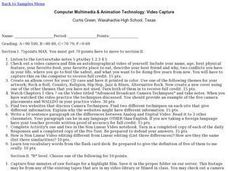Hawaiʻi State Department of Education
When We Are A Story
Drama and story elements go hand-in-hand. Have the class dive into a dramatic play to show character intention, conflict resolution, main events, and the dialogue in a Hawaiian folk tale. They read the story, then group-up to discuss and...
Curated OER
Narrative Writing Outline
Students explore the elements of a narrative for its purpose, type of audience, mood, main character, minor characters, setting, and conflicts in the story. A story outline is developed and a five paragraph essay composed in this lesson.
Curated OER
Creating Clinflict Through Gibberish
Young scholars explore ways to communicate and solve conflict. At the beginning of class, students must communicate emotions without using words. They brainstorm important relationships in their lives. Next, groups of young scholars...
Curated OER
We Tell Stories
Young readers bring characters to life by working in small groups to script and perform stories that contain a community concept. Detailed questions and activities are outlined for the class. Consider having your groups create...
Hawaiʻi State Department of Education
Poems That Dance
Combine the elements of dance with the actions in a poem. Learners review basic grammar, write an action-packed cinquain poem, and then choreograph a dance based on their cinquains. After the dances are done, they'll discuss the elements...
Curated OER
Image Conscious
Students take a stand on the concept of changing their appearance. In this changing of ones image instructional activity, students create a design that would change their image and discuss the age they think they should be to make that...
Curated OER
Mother, May I Communicate?
Students participate in a unique version of the game Mother, May I. They play the game to explore how to positively communicate their needs, wants and feelings, and to demonstrate how to react to problems.
Curated OER
Theatre Lesson Plan: Finding Your Way
Second graders identify story elements in familiar stories from their lives. In this story elements instructional activity, 2nd graders act out familiar activities by following directions. Students read a story and discuss the story...
Curated OER
Philadelphia Museum of Art
Pupils study paintings and use their knowledge of story elements to analyze the art. In this art analysis lesson, students review a novel for its elements. Pupils study the image At the Moulin Rouge: The Dance and discuss the story...
Curated OER
Thornton Wilder's Our Town: The Reader as Writer
Students read a play and create their own play using Thornton Wilder's Our Townas a resource. In this play lesson, students analyze how theatrical elements contribute to a play's meanings and effects. Students recognize differences...
Curated OER
Details, Details: How Choices Reveal Character, Setting, Tone, and Theme. (Analyzing and Interpreting, Making Inferences)
Students respond to works of art. In this art interpretation lesson, students examine images of art while using concepts they learned as they read literary pieces. They detail the setting, characters, and the mood and theme of the works...
Curated OER
Philanthropic Literature Lesson 1: The Lonely Fish
Students investigate the concepts of sharing and good citizenship, and how they contribute to a peaceful society. They work on problem solving and critical thinking skills after listening to Marcus Pfister's, The Rainbow Fish.
Curated OER
Computer Multimedia and Animation Technology: Video Capture
Students explore multimedia and animation technology. They create an autobiographical film of themselves and an album cover for their CD case. They watch a video and take notes to discover the five camera placements in their practice...














